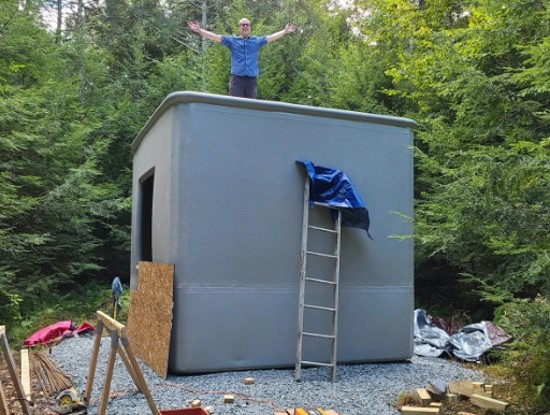Backyard birthday celebrations often come with a bouncy castle that is inflated to give the children a place to literally bounce off the walls and floor. But what if you took the idea of a big inflatable and used it as a framework for building a house? That’s what Automatic Construction, a New York City-based construction company is doing.
The inflatable is brought to a building site and blown up. Concrete is then pumped into the walls. A house constructed this way can be built in an hour at a cost that is 20% of cast-in-place concrete methods (not including the finishings). What we are talking about is $107 to $321 per square metre ($10 to $30 per square foot compared to $1,076 to $2,152 per square metre ($100 to $200 per square foot) for new construction in the U.S.
Your building framework is a flexible plastic fabric that includes an internal shell with reinforcements and three-dimensional structures. The air pump takes 15 minutes on site to inflate. The concrete then is pumped into it in a little more than an hour. The concrete used can be ready mix, air crete, sustainable cement that sequesters carbon dioxide, or other pumpable building materials. As it fills the inflatable the air holding the frame is slowly removed leaving a 4-inch-thick walled building laced with polyester threads called drop-stitch fibres. This same material is currently used to make paddle boards and kayaks because the threads provide structural reinforcement.
Once poured the inflatable can be removed, rolled up and used again. Meanwhile, the internal shell remains with the concrete curing in two days. The structure is both airtight and waterproof. It meets the highest building code standards for insulation. Finishings are then added such as flooring, drywall, electrical, plumbing, windows and doors.
Automatic Construction has plans for inflatables to be used in all kinds of building infrastructure including pools and tunnels. It sees inflatables for high-rise building construction, military installations, and even future settlements on Mars.
In an October article appearing in Fast Company, written by Elissaveta Brandon, she remarks that the world is “mired in a housing crisis…by 2030, the UN estimates we will need to build 96,000 affordable homes per day to house the 3 billion people who will need access to adequate housing.” It would seem, therefore, that the timing for this type of building solution couldn’t be better.
So far Automatic Construction has built a 9.3 square metre (100-square-foot) (seen in the picture at the top of this article), an 18.6 square metre (200-square-foot) structure and is working on a 60.4 square metre (650-square-foot) single-storey home in Upstate New York.
In its 2021 patent filing, written by Alex Bell, CEO of the company, describes the construction method as a fillable container that can be configured to suit different needs and that can include reinforcement components like rebar to be added in suitable positions as the structure is filled.
Who would have thought bouncy castles could lead to a breakthrough idea in home construction?
















